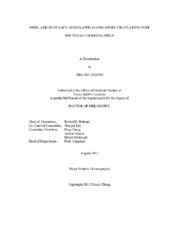| dc.description.abstract | Numerical experiments are used to study the wind- and buoyancy-modulated along-shore circulation over the Texas-Louisiana continental shelf inshore of 50-m water depth. Most attention is given to circulation in the non-summer flow regime. A major focus of this study is on a unique along-shore flow phenomenon – convergent along- shore flows, which is controlled jointly by wind forcing and buoyancy fluxes from the Mississippi-Atchafalaya river plume. The second problem addresses the forcing effect of buoyancy on the general along-shore circulation pattern over the shelf in non-summer.
The convergent along-shore flows are characterized by down-coast flow from the northern shelf encountering up-coast flow from the southern shelf. This phenomenon is explored for both weather band and seasonal timescales. For the weather band, investigations are focused on non-summer convergent events. The formation of convergent flows is primarily caused by along-coast variation in the along-shore component of wind forcing, which in turn is due to the curvature of the Texas-Louisiana coastline. In general, along-shore currents are well correlated with along-shore winds. However, the points of convergence of currents and winds are not co-located; but rather, points of convergence of currents typically occur down-coast of points of convergence of wind. This offset is mainly caused by buoyancy forcing that forces down-coast currents and drives the point of convergence of currents further down-coast. No specific temporal shift pattern is found for the weather-band convergence, whereas monthly monthly mean convergence exhibits a prominent pattern of seasonal along-coast migration. Buoyancy forcing in the non-summer along-shore flow is investigated in detail in the second part of this study. During non-summer, under down-coast wind forcing, the Mississippi-Atchafalaya river plume exhibits a bottom-advected pattern, for which isopycnals strongly interact with the sea floor. The density front is fairly wide and spans nearly across the entire shelf. Within the front, vertical shear of the alongshore flow is in thermal wind balance with the cross-shore density gradient, and the shear causes a slight reversal of alongshore flow near the bottom. An alongshore flow estimated by the thermal wind relation, along with an assumption of zero bottom reference velocity, agrees well with the actual alongshore flow. | en |


